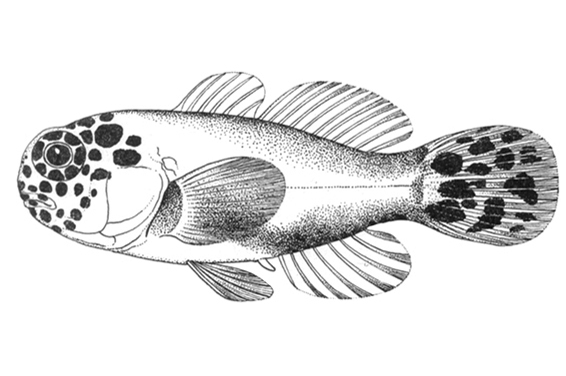- Classification
- ACTINOPTERYGII
- PERCIFORMES
- GOBIIDAE
- Gobiodon
- spilophthalmus
Whitelined Coralgoby, Gobiodon spilophthalmus Fowler 1944
Other Names: Whitelined Coral Goby, White-lined Coral Goby

An illustration of a Whitelined Coralgoby, Gobiodon spilophthalmus. Source: H.W. Fowler, 1944 - Fishes obtained in the New Hebrides by Dr. Edward L. Jackson. License: Copyright expired
Summary:
A uniformly black coralgoby, with juveniles having large spots on the head and tail and often broad dark stripes along the body. The Whitelined Coralgoby is easily confused with (and may be conspecific with one of) a number of other species of Gobiodon having juveniles with similar coloration.
These highly specialised gobies live in monogamous pairs between branches of living acroporid corals.
These highly specialised gobies live in monogamous pairs between branches of living acroporid corals.
Cite this page as:
Bray, D.J. 2020, Gobiodon spilophthalmus in Fishes of Australia, accessed 19 Apr 2024, https://fishesofaustralia.net.au/Home/species/2228
Whitelined Coralgoby, Gobiodon spilophthalmus Fowler 1944
More Info
|
Distribution |
Offshore reefs of NW Western Australia, and the Great Barrier Reef, Queensland. Elsewhere the species occurs in the tropical, west Pacific. |
|
Feeding |
|
|
Species Citation |
Gobiodon spilophthalmus Fowler 1944, Proceedings of the Academy of Natural Sciences, Philadelphia 7: 183, figs 30-31. Type locality: Vanuatu (as New Hebrides). |
|
Author |
Bray, D.J. 2020 |
|
Resources |
Whitelined Coralgoby, Gobiodon spilophthalmus Fowler 1944
References
Duchene, D., Klanten, S.O., Munday, P.L., Herler, J. & van Herwerden, L. 2013. Phylogenetic evidence for recent diversification of obligate coral-dwelling gobies compared with their host corals. Molecular Phylogenetics and Evolution 69: 123-132
Fowler, H.W. 1944. Fishes obtained in the New Hebrides by Dr. Edward L. Jackson. Proceedings of the Academy of Natural Sciences, Philadelphia 7: 1-408 https://www.jstor.org/stable/4064356
Harold, A.S., Winterbottom, R., Munday, P.L. & Chapman, R.W. 2008. Phylogenetic relationships of Indo-Pacific coral gobies of the genus Gobiodon (Teleostei: Gobiidae), based on morphological and molecular data. Bulletin of Marine Science 82(1): 119-136. (as Gobiodon unicolor) See ref online
Herler, J., Bogorodsky, S. & Suzuki, T. 2013. Four new species of coral gobies (Teleostei: Gobiidae: Gobiodon), with comments on their relationships within the genus. Zootaxa 3709(4): 301–329 http://dx.doi.org/10.11646/zootaxa.3709.4.1
Hing, M.L., Klanten, O.S., b, Marian Y.L. Wong, M.Y.L. & Dowton, M. Drivers of sociality in Gobiodon fishes: An assessment of phylogeny, ecology and life-history. Molecular Phylogenetics and Evolution 137: 263-273 https://doi.org/10.1016/j.ympev.2019.05.020
Larson, H.K. & Murdy, E.O. 2001. Eleotridae, Gobiidae. pp. 3574-3604 in Carpenter, K.E. & Niem, T.H. (eds). The Living Marine Resources of the Western Central Pacific. FAO Species Identification Guide for Fisheries Purposes. Rome : FAO Vol. 6 pp. 3381-4218.
Moore, G. & Morrison, S. 2009. Fishes of three North West Shelf atolls off Western Australia: Mermaid (Rowley Shoals), Scott and Seringapatam Reefs. Records of the Western Australian Museum, Supplement 77: 221-255
Munday, P.L., Harold, A.S. & Winterbottom, R.W. 1999. Guide to coral-dwelling gobies, genus Gobiodon (Gobiidae) from Papua New Guinea and the Great Barrier Reef. Revue Française d'Aquariologie et Herpétologie 26: 53-58
Myers, R.F. 1999. Micronesian Reef Fishes. A comprehensive guide to the coral reef fishes of Micronesia. Guam : Coral Graphics vi 330 pp. 192 pls.
Sawada, Y. & Arai, R. 1972. Gobiodon albofasciatus, a new coral-goby from the Ryukyu Islands, Japan. Bulletin of the National Science Museum, Tokyo 15(3): 415-420 figs 1-6 (described as Gobiodon albofasciatus)
Shibukawa, K., Suzuki, T. & Aizawa, M. 2013. Gobiodon aoyagii, a new coral goby (Actinopterygii, Gobiidae, Gobiinae) from the West Pacific, with redescription of a similarly-colored congener Gobiodon erythrospilus Bleeker, 1875. Bulletin of the National Museum of Nature and Science A 39(3): 143-165

